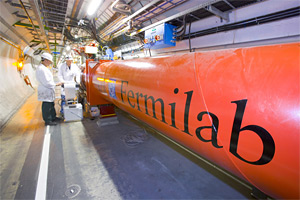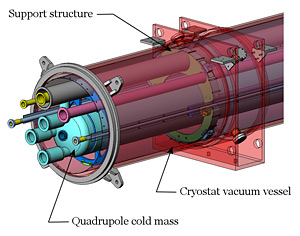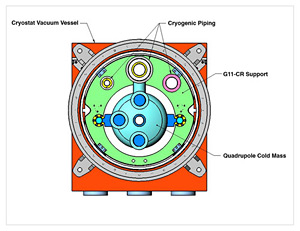Fermilab Statement on LHC Magnet Test Failure
 |
| An inner-triplet quadrupole during installation in June 2006. |
 |
| Drawing of the end of an inner-triplet quadrupole showing the cold mass, cryostat vacuum vessel, and internal G-11 support structure. |
 |
| Cross-section drawing of an inner-triplet quadrupole magnet at one of
the support points. |
On Tuesday, March 27, there was a serious failure in a high-pressure test at CERN of a Fermilab-built “inner-triplet” series of three quadrupole magnets in the tunnel of the Large Hadron Collider. The magnets focus the particle beams prior to collision at each of four interaction points around the accelerator.
Safety precautions were followed during the test, and no one was injured.
A full investigation of the failure is underway, but preliminary indications are that structures supporting the inner “cold mass” of one of the three magnets within its enclosing cryostat broke at a pressure of 20 atmospheres, in response to asymmetric forces applied during the test. Such forces are expected on occasion during normal operation of the LHC. The failure does not concern the magnets or the cold masses themselves, but rather their assembly in the cryostat.
While the full cause of the problem is not yet known, failure to account for the asymmetric loads in the engineering design of the magnet appears to be a likely cause. The test configuration corresponds to conditions that occur during a magnet quench, when a superconducting magnet suddenly “goes normal,” releasing large amounts of energy. They may also occur during magnet cooldown and during certain other conditions such as refrigerator failure. From 1998 to 2002, Fermilab conducted four engineering reviews of the magnets by experts from Fermilab, other US national laboratories and CERN. The reviews do not appear to have addressed these asymmetric loads. Tests at Fermilab were done on single magnets where such loads do not develop.
At this point the consequences, if any, for the LHC schedule are not yet known.
Fermilab Director Pier Oddone has called CERN Director General Robert Aymar to explain that addressing the LHC magnet problem has the highest priority for Fermilab and that the laboratory will do whatever is necessary to get things back on track. Oddone and Aymar will speak again at the end of the week.
Large teams at Fermilab and at CERN are working on understanding and addressing the problem. They are reviewing the documentation, redoing calculations, performing mechanical tests and analyzing the damage to the magnet triplet at CERN. Fermilab expects to have updated information at the end of the week.
In addition to working with CERN to do everything necessary to fix the problem, Fermilab will conduct an external review of the factors that led to the magnet failure and to an earlier problem with heat exchangers in the same quadrupoles. The earlier problem with heat exchangers has been largely fixed.
Fermilab has designed, built, assembled and delivered nine 43-foot (13-meter) quadrupole magnet assemblies to CERN. In addition, Fermilab also assembled into cryostats and shipped to CERN 18 similar KEK-designed magnets that were built in industry in Japan and cold-tested at KEK. Each “inner triplet” set of magnets contains two Japanese magnets and one Fermilab-built magnet assembly. The cryostats for the triplets were designed and procured locally by Fermilab. Final assembly into cryostats and acceptance testing was done at Fermilab.
Fermilab Today will publish updated information about this magnet failure and possible solutions as it becomes available.
LHC Magnet Updates
|